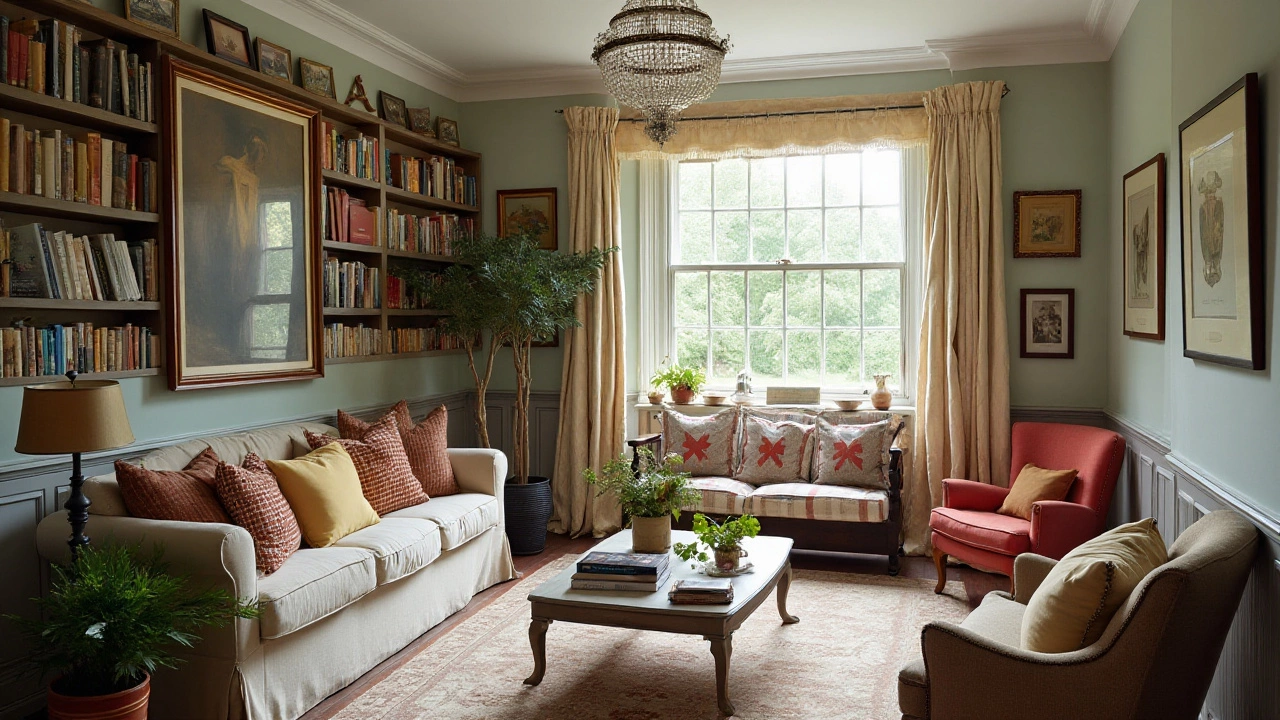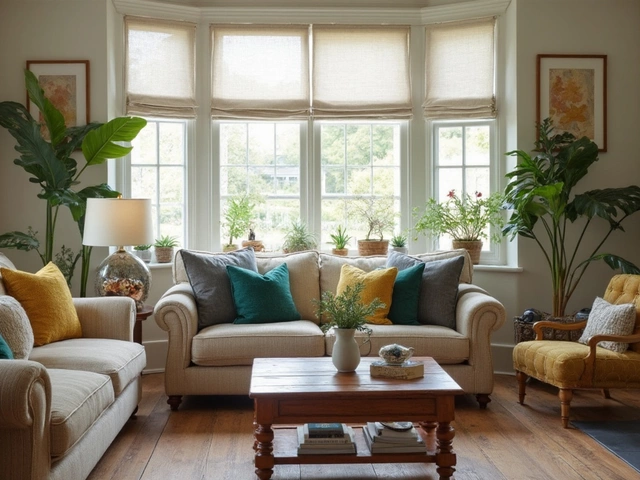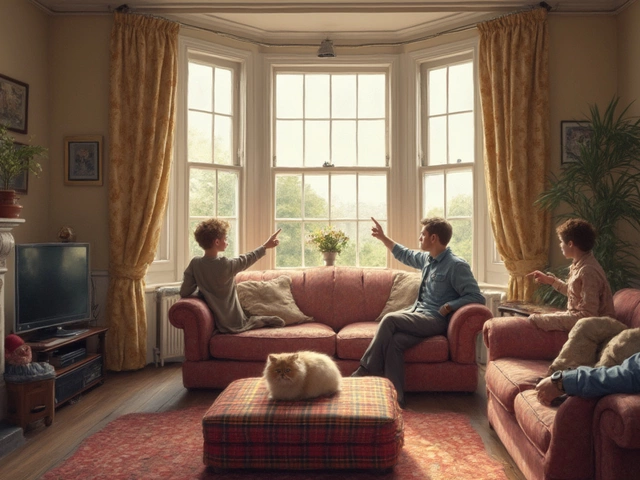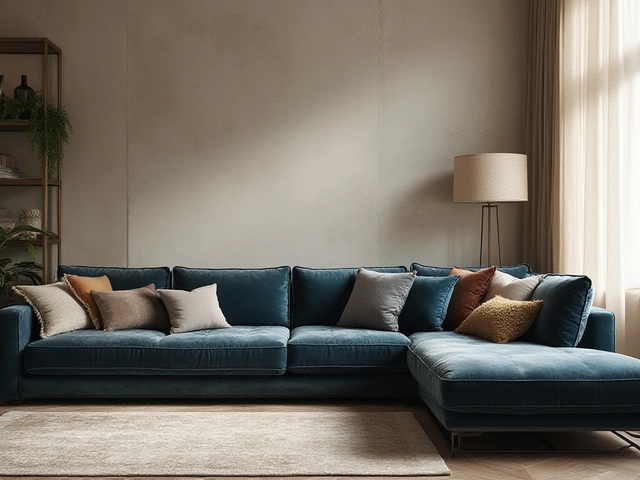Expert Tips for Transforming Your Living Room into a Stylish Haven

Your living room is more than just a place to watch TV or host friends; it's a reflection of your personal style and a sanctuary for relaxation. Making it look inviting and stylish doesn’t have to be overwhelming.
With strategic choices, your living space can transform into a functional yet beautiful environment. From selecting the ideal color palette to arranging furniture for comfort and flow, each decision can significantly enhance your living room's allure.
Paying attention to lighting and accessories further complements the overall design, turning an ordinary area into an extraordinary space. It's your chance to blend fashion with functionality, and create a space that resonates with warmth and elegance.
- Choosing the Right Color Palette
- Selecting Optimal Furniture
- Incorporating the Perfect Lighting
- Using Accessories Strategically
- Creating a Focal Point
- Maintaining Balance and Harmony
Choosing the Right Color Palette
Deciding on the perfect color palette for your living room sets the stage for every other decor decision. The colors you pick influence not only the aesthetic but also the mood and atmosphere of the room. A well-chosen palette can make a small space feel larger, or transform a vast area into a cozy haven. Start by considering the purpose of your living room. Are you looking for a tranquil retreat, a vibrant space for social gatherings, or a mix of both? Your intentions will guide your color choices significantly.
Designers often suggest starting with a neutral base. Shades like white, beige, or light gray serve as excellent foundations. These hues don’t overpower the space, making it easier to introduce statement pieces in bolder colors. They also provide flexibility, allowing you to change accessories or introduce seasonal decor with ease, without worrying about clashing tones. In homes with open spaces, maintaining a cohesive color scheme with adjacent rooms prevents visual dissonance, enhancing continuity throughout your home.
Accents are where your personality can truly shine. Consider the psychology of color when selecting your accents. Blues and greens often promote calmness and relaxation, while yellows can energize a room with warmth. A pop of red or orange could spark conversation and excitement in more social spaces. A balanced color palette would typically involve a mix of warm and cool accents to maintain both interest and harmony. As the celebrated interior designer, Kelly Wearstler, once said:
"A common color theme, even if subtle, can weave a sense of togetherness through different rooms."
Utilize textiles to introduce color in clever ways. Throw pillows, area rugs, or curtains are not just practical but also pivotal color players in your decor strategy. Swapping these out according to seasons or mood changes is an effortless and cost-effective method to keep your living room feeling fresh. Remember to consider the patterns you introduce. A heavily patterned sofa or rug can become the focal point, so balance them with more subdued surroundings. This approach ensures that your living room remains inviting rather than overwhelming.
For those unsure of where to begin, looking into current trends might offer inspiration. Earthy tones, such as terracotta and olive, have been increasingly popular, bringing a touch of nature indoors. These colors pair beautifully with natural materials like wood or stone, creating a warm, organic ambiance. But remember, trends come and go, so ensure your core palette reflects your enduring personal style and comfort.
Selecting Optimal Furniture
Choosing the right furniture is crucial in crafting a living room decor that feels both stylish and functional. It isn’t just about picking pieces that fit the space; it's an art of selecting items that harmonize with the room's vibe and utility. Begin by analyzing the space. Consider the area where sunlight hits during the day, because it affects not just the mood but also the colors of the furnishings over time. A room with abundant natural light might benefit from darker, richer furniture tones that won’t fade as quickly, while a room that lacks sunlight thrives with lighter shades that can brighten up the space.
Next, ponder over the function of your living room. Is it primarily for relaxation or entertaining? A room designed for hosting guests frequently might necessitate more seating than one meant for family movie nights. For a family-centric living room, consider modular sofas or sectionals that offer flexibility for various users and uses. They can be rearranged easily based on the day's need or the number of guests. While focusing on functionality, do not compromise on style. Invest in furniture with durable materials but elegant designs so they withstand the test of time while embodying current trends.
Understanding Proportion and Scale
Proportion and scale are often overlooked, yet they are key to perfecting the interior design of any room. A common mistake in furniture selection is size mismatch; a large, plush couch might dwarf a small room, while a small table may seem lost in a spacious area. Use balance as your guiding principle—it’s about matching the furniture size with the room scale. Large open spaces can accommodate oversized sectionals or expansive coffee tables. Conversely, smaller rooms benefit from sleek, minimalist designs that offer full functionality without crowding. Don't hesitate to experiment with layout arrangements before settling. Sometimes, a fresh perspective can reveal better configurations.
As interior designer Nate Berkus once said, "Your home should tell the story of who you are, and be a collection of what you love brought together under one roof." His words underscore the importance of personal style in furniture choice. Do not just follow trends that won’t last but include pieces that resonate with your personality and the ambiance you wish to create.
Quality Over Quantity
Furnish with intention. It's often better to invest in fewer higher-quality pieces than to clutter with numerous low-cost items. Quality furniture is not just about brand names or hefty price tags; it’s about durability, craftsmanship, and comfort. A well-made sofa or artisan-crafted coffee table can become timeless statements in a living room, drawing admiration for years. Look for solid wood construction or fabrics that are both aesthetically pleasing and sturdy. Removable and washable slipcovers are a practical feature in homes with children or pets, allowing for easy maintenance.
Consider incorporating some accent furniture to create visual interest. This could be achieved through a bold armchair in a contrasting color, or a vintage side table with intricate carvings. Such pieces can act as focal points, providing visual play and breaking up monotony. Lastly, maintain texture diversity. Mixing upholstery textures like leather with fabric cushions, or pairing a wooden table with a plush rug can add layers of coziness and richness, perfect for making a stylish living room.

Incorporating the Perfect Lighting
Lighting is an essential aspect of any well-decorated living room, significantly influencing the mood and functionality of the space. To craft an inviting atmosphere, it's crucial to layer different light sources. Begin with ambient lighting, which serves as the primary source of illumination. This is typically accomplished with ceiling fixtures such as chandeliers, recessed lights, or pendant lamps. Ambient light should be soft yet sufficient to distribute light evenly across the room, making it comfortable for everyday activities. Consider dimmers to adjust the light intensity to suit different moods or gatherings, offering versatility at your fingertips.
Next, accent lighting plays a pivotal role in accentuating specific features, art, or architectural elements of the room. Often, these lights are more focused and are used to highlight the features you wish to draw attention to. Wall sconces or picture lights are excellent choices here. They can transform a simple living room into a gallery-like experience by casting light strategically. An often-overlooked fact is that accent lighting can create illusions of space, making your room appear more spacious and dynamic.
Task lighting is another critical layer, offering more directional lighting for activities like reading or working on hobbies. Table lamps, reading lights, or adjustable floor lamps offer this functionality. Ensuring your task lights are well-placed can prevent eye strain and provide the comfort needed for prolonged use. When choosing task lighting, consider both its function and how its design complements or contrasts with the existing décor.
"Proper lighting can direct the focus, creating visual pathways throughout your environment," noted renowned designer Nate Berkus, underscoring its importance.
An emerging trend in living room decor is the incorporation of smart lighting systems. These allow for customization and control via smart home devices, enhancing convenience and energy efficiency. According to a recent survey, homes that integrated smart lighting saved up to 25% on energy, a testament to its cost-effectiveness. This control can extend to color temperature adjustment, creating a range of lighting scenes from warm, cozy tones to cool, energizing brightness.
Finally, don't disregard natural light. Maximize daylight by utilizing sheer curtains rather than heavy drapes, allowing sunlight to filter through, offering a natural and refreshing ambiance. Position mirrors creatively to reflect light throughout the area, enhancing brightness and giving the illusion of a larger space. It's all about balancing natural and artificial lighting to achieve a harmonious atmosphere that is both welcoming and stylish.
Incorporate these strategies thoughtfully to create a living space that is both comfortable and chic, ensuring your home remains a stylish haven where lighting serves both aesthetic and practical purposes, truly transforming your living room into a place of beauty and peace.
Using Accessories Strategically
In the quest to make your living room not only charming but also reflective of your personal taste, interior design tips suggest that accessories play a crucial role. Think about accessories as the jewelry of your room; they add sparkle and personality, speaking volumes of your style like nothing else can. This transformative power begins with understanding the sheer breadth of accessories available, from throw pillows to art pieces, and even vintage finds. When strategically placed, these items evoke emotions and create visual interest, enveloping your home in warmth and story.
The key to effective use of accessories lies in balance. While it can be tempting to adorn every corner with trinkets, restraint often results in a more polished aesthetic. Selecting a few standout pieces can offer more impact than cluttering surfaces with smaller items. Start with art or photographs that resonate with you. One large piece can serve as a focal point, uniting the room’s various elements. According to interior designer Nate Berkus, "Your home should tell the story of who you are and be a collection of what you love." This principle is akin to assembling a personal art gallery, showcasing not only taste but the journey you've embarked on.
Curating with Purpose
As you curate accessories, consider their function alongside their form. Home improvement isn’t just about aesthetics; it’s about crafting a space that works cohesively with your lifestyle. Take vases for example, which not only enhance decor but also serve a practical purpose when filled with fresh flowers. Think about how a charming basket might double as storage for those rogue magazines or blankets. Each piece should harmonize with its surroundings, providing utility without sacrificing style.
Creating layers is another deliberate accessory strategy. By grouping items of different heights and textures, such as placing a silky cushion alongside a coarse woven throw, you inject depth into the room. Layers invite the eye to explore, providing a remedy to flatness which can sometimes plague living spaces. Items arranged in odd numbers often feel more natural compared to even numbers, lending a curated yet unstudied vibe.
Seasons and Trends
Another clever practice involves rotating accessories with the seasons. In doing so, your stylish living room remains dynamic, representative of change and adaptation. Swapping bright hues for warm earth tones transforms a summery room into an autumnal haven, offering comfort and novelty. Trends in decor come and go, but integrating contemporary pieces with timeless classics maintains freshness without the need for an entire overhaul each year.
To ensure synergy, remember to weave in elements present across your decor into your accessories. If your space incorporates specific metals or wood tones, allow them to echo through your accessory choices. This connectivity ensures a seamless aesthetic throughout, rather than isolated pockets of theme. Taking the time to unify your accessories with the larger room design yields a masterpiece of both comfort and style, crafting an atmosphere that is a true reflection of its inhabitants.

Creating a Focal Point
Designing your living room around a central focal point can breathe new life into the space, drawing attention and setting the stage for all other decor elements. This concept directs the eye to a specific area, usually the most striking or interesting part of the room, ensuring a harmonious blend of aesthetics and functionality. Consider the fireplace, a timeless choice that naturally commands attention. If you have one, a beautifully crafted mantel can serve as an ideal focal point. Alternatively, an art piece can also provide a dramatic flair. Choose artwork that resonates with your personality, perhaps something that evokes a story or shares a part of your journey.
In homes where neither a fireplace nor artwork fits the bill, technology can step in to provide a solution. A large flat-screen television can become a modern-day focal point when aligned with the styling of the room. It’s important, though, to ensure that the television doesn’t dominate other elements to the extent of overshadowing them. Balance is key, with the aim of integrating technology into the decor rather than having it stick out prominently. You might wonder, what if my space doesn’t have any of these elements? A statement piece of furniture, such as a bold-colored sofa or a designer chair, can serve this purpose effectively, creating intrigue and adding aesthetic appeal.
Lighting plays a crucial role in highlighting your chosen focal point. Imagine a carefully placed spotlight illuminating a cherished painting, bringing out its vibrant colors, creating dynamic shadows, and transforming the living room decor. To avoid the focal point becoming static, you can switch up lighting occasionally with adjustable dimmers or color-changing bulbs. This not only keeps the room interesting but also adjusts the ambiance to suit different moods and occasions. Consider illuminating a feature wall with texture or patterned wallpaper, which is gaining popularity as a visually captivating focal point.
As the renowned designer Nate Berkus once said, "Your home should tell the story of who you are, and be a collection of what you love."This principle applies perfectly when creating a focal point in your living room. Each element you select—from the art you hang to the furniture you place—should resonate personally and contribute to the overall narrative of your space. Explore different textures, shapes, and colors, allowing each choice to weave seamlessly into the interactive story of your living room.
Tables are more than just pieces to hold your coffee; they can function as effective focal points too. For example, a unique or antique coffee table can captivate guests, drawing them into the center of the room's layout. Include elements of varied height on this surface, such as tall vases and low sculptures, to add depth and visual intrigue. Including personal mementos or decorative artifacts can infuse character, making your focal point both a visual anchor and a conversation starter. These additions don’t just dress the table but also contribute layers of meaning and personal significance to your home environment.
Not to be overlooked, a living room's view can become its own stunning focal point. Large windows exposing beautiful landscapes or cityscapes should not be blocked but rather framed with complementary curtains and a layout oriented to enhance the natural view. This strategy elevates the room by incorporating the outdoors, providing a sense of openness and serenity. Use the following table as a guide to compare various focal point ideas based on room size, style, and budget:
| Focal Point Idea | Room Size | Style Adaptability | Budget |
|---|---|---|---|
| Fireplace Mantel | Large | Classic | High |
| Artwork | Small to Large | Versatile | Mid-Range |
| Television | Medium to Large | Modern | Varies |
| Statement Furniture | Any | Contemporary | Varies |
| View Windows | Large | Natural | Mid-Range |
Whether you choose a traditional mantel, modern technology, or stunning artwork, a well-thought-out focal point can transform your living room into a space that is not only welcoming and stylish but also tells a story. Just remember to maintain a balance between showcasing the focal point and allowing other elements to complement it, creating a cohesive and appealing environment.
Maintaining Balance and Harmony
Achieving balance and harmony in your living room is akin to conducting a symphony, where every element plays its part to create a seamless composition of style and function. Balance in design can be categorized into symmetrical, asymmetrical, and radial, each offering different aesthetics. Symmetrical balance is achieved when objects are mirrored on either side of a central axis, lending itself to a more formal atmosphere. This style is often seen in living room decor with a classic or traditional theme, where pairs of chairs or identical table lamps frame a central point.
Asymmetrical balance, on the other hand, involves positioning dissimilar objects of equal visual weight on either side of a central point. This approach brings a dynamic and visually interesting vibe to a space, often preferred in modern or contemporary spaces. Radial balance radiates from a central point outward, like arrangements around a central coffee table, creating an equitable flow that invites conversation and interaction. Choosing the right balance approach depends largely on personal preference and the overall vibe you wish to cultivate in your stylish living room.
When designing for harmony, consider the rhythm and repetition of colors and shapes. This can be subtly achieved by using similar shapes in furniture, and repeating colors from your chosen color palette in cushions and artwork. Harmony doesn't mean monotonous; it suggests a space where different elements complement each other, avoiding any single object from dominating. Interior designers often emphasize scale and proportion in achieving harmony, ensuring that no furniture piece overwhelms the space or seems dwarfed by its surroundings. As renowned design expert Nate Berkus once said,
"Your home should tell the story of who you are, and be a collection of what you love."This means infusing personal touches that feed harmony without disrupting balance, like family photos integrated into a gallery wall or a beloved vintage piece that contrasts yet complements modern decor.
Lighting also plays a crucial role in maintaining balance and harmony. Layering light sources across the room ensures that your space is functional and inviting. A blend of ambient, task, and accent lighting contributes to a balanced atmosphere, ensuring different areas of the room are appropriately lit, enhancing both aesthetics and functionality. Statistics show that rooms with varied lighting sources are 60% more likely to be perceived as comfortable and welcoming, demonstrating the psychological impact of lighting on space perception.
Practical accessories can also serve to harmonize a room without cluttering it. Here, the principle of "less is more" often prevails. A few carefully chosen accessories can add personal style and elegance without overwhelming the senses. Consider using greenery, such as potted plants, which studies have shown can improve indoor air quality and boost mood. These simple additions can bridge gaps between different elements and styles within your living room, fostering an atmosphere of harmony and balance.


